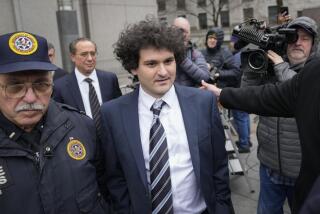VIEWPOINTS : What BankAmerica Can Do to Reverse Its Dangerous Course
- Share via
BankAmerica, on the heels of a shocking $640-million second-quarter loss, faces possibly the most difficult period in its 82-year history.
The loss, due largely to continuing problems with foreign, real estate, energy and farm loans at the company’s Bank of America unit, was the second largest in banking history and was unexpected, given that many analysts had thought the worst of the bank’s problems were over.
Now, BankAmerica faces a number of wrenching decisions. Should it sell assets and shrink? Should it undertake further cuts in personnel, which could save money but harm customer service? Should it raise new capital, and how? Should it change or restructure top management?
Meanwhile, the company must contend with possible takeover attempts while trying to maintain depositor confidence as observers wonder whether further losses are still ahead.
In an attempt to explore the various options facing BankAmerica, The Times invited bank consultants, investment analysts, academicians and investors to comment on what they think the bank’s management should do to turn the company around. Here are their comments:
BankAmerica, on the heels of a shocking $640-million second-quarter loss, faces possibly the most difficult period in its 82-year history.
The loss, due largely to continuing problems with foreign, real estate, energy and farm loans at the company’s Bank of America unit, was the second largest in banking history and was unexpected, given that many analysts had thought the worst of the bank’s problems were over.
Now, BankAmerica faces a number of wrenching decisions. Should it sell assets and shrink? Should it undertake further cuts in personnel, which could save money but harm customer service? Should it raise new capital, and how? Should it change or restructure top management?
Meanwhile, the company must contend with possible takeover attempts while trying to maintain depositor confidence as observers wonder whether further losses are still ahead.
In an attempt to explore the various options facing BankAmerica, The Times invited bank consultants, investment analysts, academicians and investors to comment on what they think the bank’s management should do to turn the company around. Here are their comments:
Bank of America needs to return to its roots, to the philosophy that puts the needs of ordinary people ahead of the short-sighted desire for immediate profits at any cost. The bank’s present management apparently feels that there is no room left for humanity in banking; that the public interest is less important than corporate self-aggrandizement. The top officers concern themselves more with the commercial interests of the bank than with the welfare of the people whose needs the bank was created to serve.
When the bank turns away from unprofitable services such as the handling of small trusts and of school savings accounts, it may, in the short run, reduce costs. But what is it doing to its future?
Not everyone can come to the bank with large deposits that will produce an immediate profit for the bank. But many of those who begin in a small way eventually become wealthier. If they begin with a bank that is concerned with their needs and their welfare, a relationship of loyalty and trust grows. In the longer term, the bank benefits from their growing affluence.
Serving the interests of ordinary people serves the interests of the bank; ignoring the needs of those people does great damage to the bank’s future.
Bank of America, in the years when it was becoming one of the world’s great financial institutions, put the welfare of the community above greed and private ambition. The bank’s branches were managed by people who were part of the communities that they served, who knew their customers and understood their needs.
Now, with the concentration of authority in top management, those lower-level employees have been turned into cogs in a machine. The bank has lost a great deal by taking away their authority and responsibility. The talents, skills and knowledge of those employees go unused, the customers have lost the personal relationships that they once had with their bankers and those few executives who control the bank’s policies have become ever more distant from the source of the bank’s strength.
Both the public and Bank of America would be better served by a return to the policies and practices of my father, whose goal in founding the bank was to build an institution deeply rooted in humanity, a trustee serving a great public purpose.
More to Read
Inside the business of entertainment
The Wide Shot brings you news, analysis and insights on everything from streaming wars to production — and what it all means for the future.
You may occasionally receive promotional content from the Los Angeles Times.










